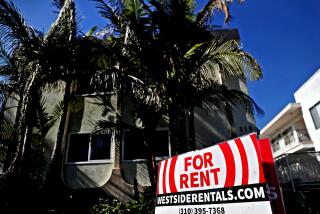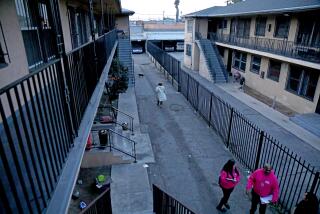Tenant Could Feel Environmental Impact
- Share via
Tenants who assume their landlords are responsible for environmental problems on the property could be in for an expensive surprise.
Many landlords are trying to shift more accountability onto tenants, says Maura O’Connor, a partner in the Los Angeles law office of Arter & Hadden.
“A lot of tenants don’t think much about environmental risks, but they should, because federal and state environmental laws provide that either the owner or the operator of a property can be held liable for cleanup costs,” O’Connor said. And if the government has its choice of going after a wealthy tenant as opposed to a not-so-wealthy landlord, the tenant could wind up paying, she added.
O’Connor advised that tenants who are unsure of a property’s environmental history can have a Phase I assessment performed by an environmental engineer or consulting firm, usually for about $2,500 to $3,000. It involves examining documents to look for records of toxic spills or other environmental problems at a property.
“If you’re a tenant moving into a new office building that was built in the last 10 years, you may not feel the need for an inspection, but if you’re a tenant moving into an old industrial park, you’re going to want to do it,” O’Connor said. Older office buildings can present problems too, such as asbestos, lead paint or other materials that have since been deemed dangerous.
If a Phase I assessment suggests that a property could have problems, the next step is a Phase II assessment--an actual inspection. Costs can vary widely, depending on the size and type of property. A 20-acre industrial site that requires sampling every quarter-acre could be quite expensive, but the inspection could be relatively inexpensive at a building where the only concern might be looking for asbestos under the roof tiles.
O’Connor said landlords often will agree to bear the cost of cleaning up unknown past problems that are discovered sometime in the future, but an increasing number are asking tenants to bear some of those costs.
An issue most tenants don’t think about, however, is the question of who pays for future problems caused by someone else.
“If some third party dumps on an industrial property at night, whose responsibility is it to pay for the cleanup--the owner or the tenant? It sounds dramatic, but things like this happen,” O’Connor said. The risks of such third-party actions are one of the most hotly negotiated points in industrial leases today, she added.
A possible solution is environmental insurance, which can cover cleanup expenses for pollution spills, legal liability, personal injury and a host of other costs associated with environmental risks. O’Connor said such insurance at one time was prohibitively expensive but has become more practically priced within the last several years.
A variety of policies are available, enabling landlords and tenants to sidestep the squabbling, uncertainty and ill will that can ensue if environmental concerns are not addressed during lease negotiations.
More to Read
Inside the business of entertainment
The Wide Shot brings you news, analysis and insights on everything from streaming wars to production — and what it all means for the future.
You may occasionally receive promotional content from the Los Angeles Times.










